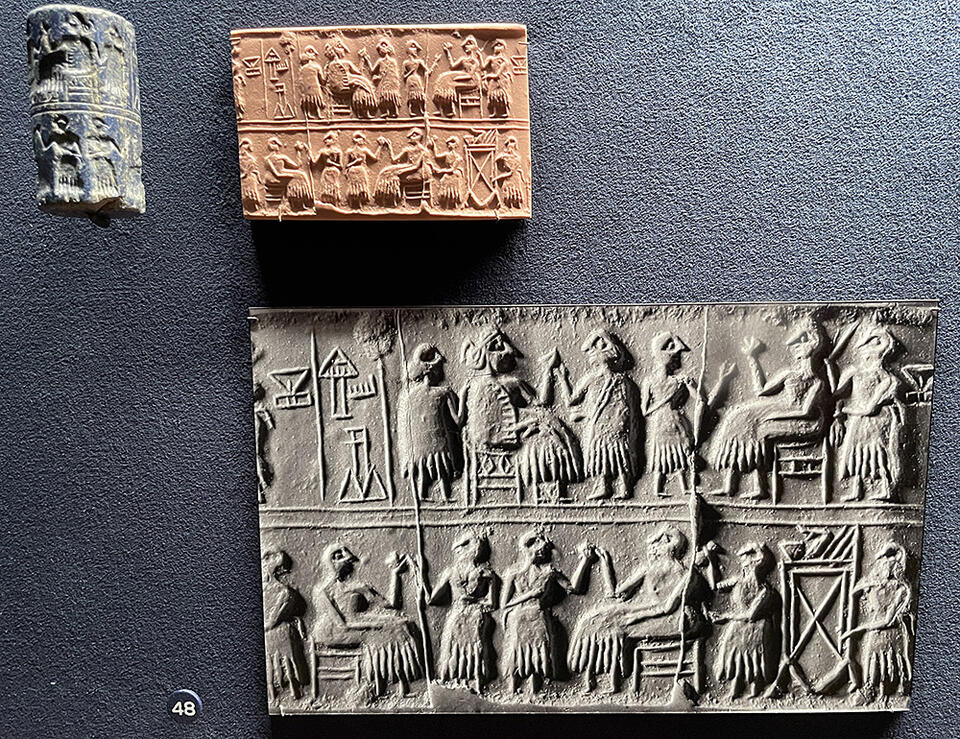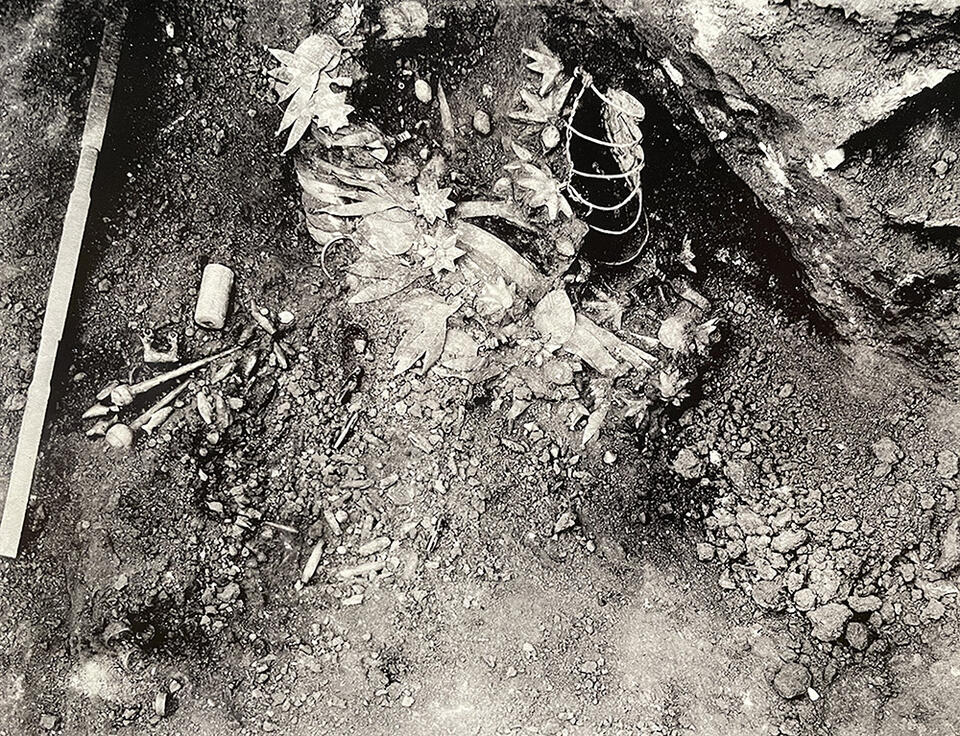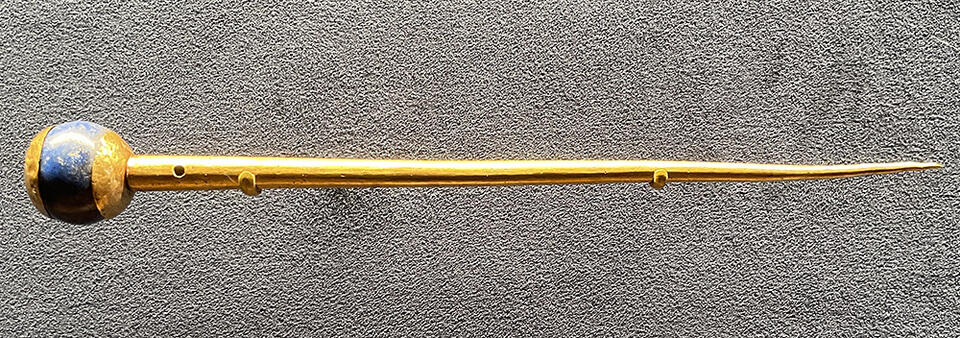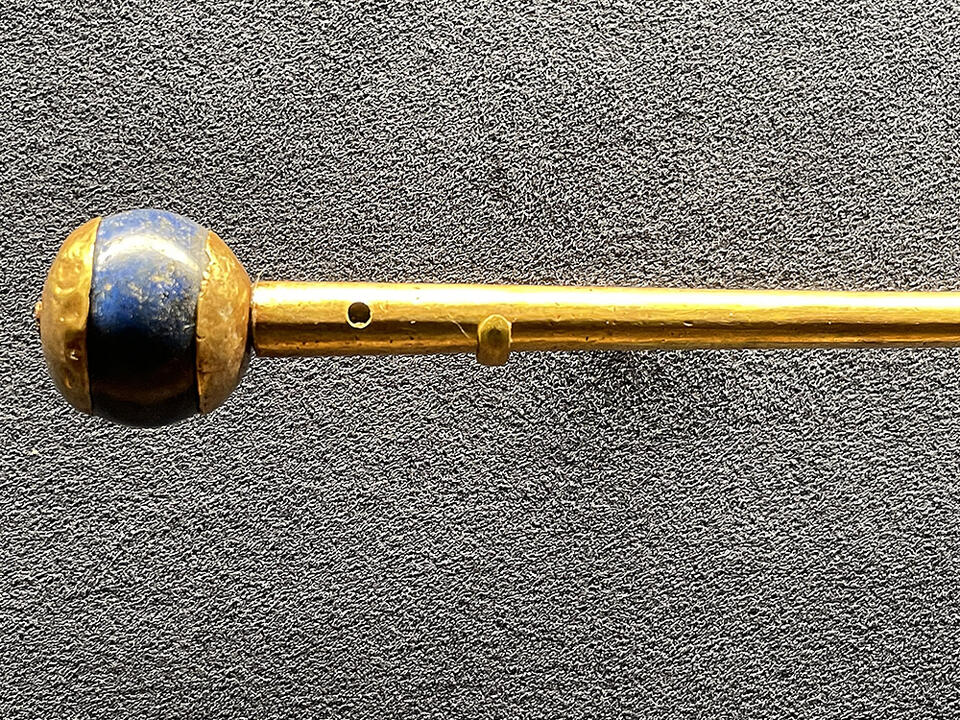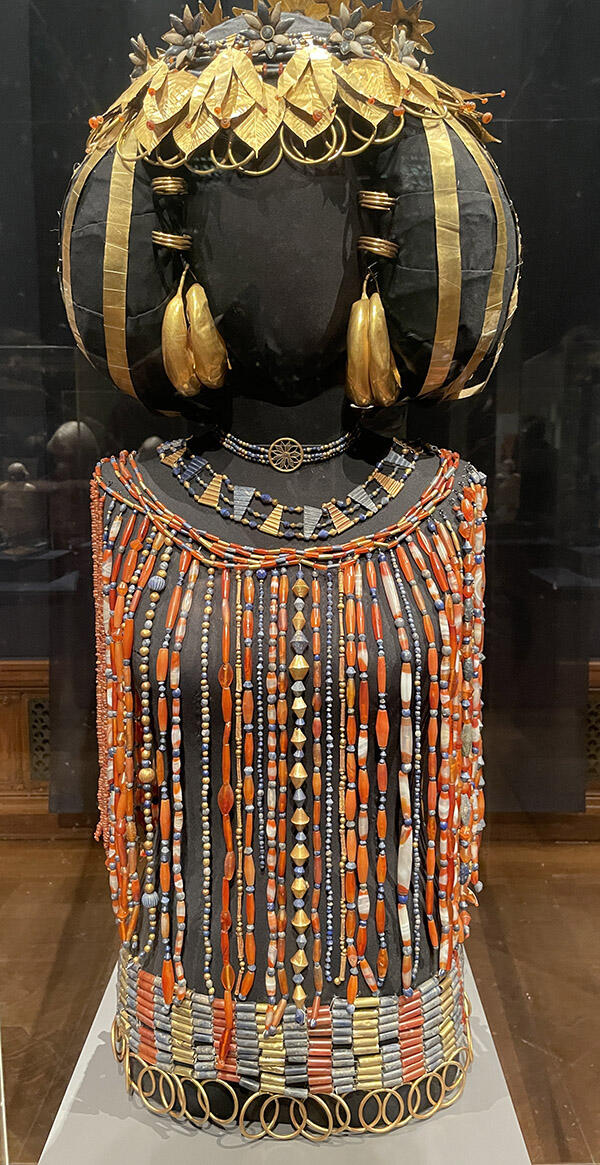April 6th, 2023
We previously discussed Queen Puabi's spectacular Indus-themed burial shroud; here we look at some of the other artifacts we have from this extraordinary female ruler of the Mesopotamian city-state of Ur around 2500 BCE. Not much is known about her, and some details like her exact status as Queen may be in dispute, but the evidence of the She Who Wrote: Enheduanna and Women of Mesopotamia, ca. 3400–2000 B.C. is that women could have great prominence at the time in the region. "Enheduanna was not only the high priestess of the moon god in Ur but also the first author in history whose name can be directly linked to her texts," in the words of the exhibition catalog (p. 178); she was also the daughter of King Sargon (2334–2279 BCE) who famously boasted of ships from Meluha who most scholars identify with the ancient Indus civilization from which the carnelian in Queen Puabi's shroud most likely came from.
The first image [1] is a cylinder seal (top left), the sealing made from it, blown-up to show the details in the bottom black and white image.1 The caption in the excellent catalog by Sidney Babcock and and Erhan Tamur for the exhibition at the Morgan Library in New York, She Who Wrote reads:
"Seated in the top register of this banquet scene, Queen Puabi is first announced by the seal's inscription, which names her specifically.The seal carver further emphasized her stately status with carefully rendered elements. Puabi's chair is more decorative than those of the other celebrants, all of whom are men. Special attention was also given to her dress, draped over one shoulder, as well as her looped hair bun and prominent facial features. One of her two female attendants gently rests her hand on Puabi's back, an easily missed detail suggesting the close relationship between an elite woman and her female entourage. LJS [Laleh Javaheri-Saatchi]."
The second image [2], is a "field photograph of Queen Puabi's tomb, showing her headdress and jewelry in position. Note the seal and the pins by the right shoulder."2
The third and fourth images [3, 4] are close-ups of the pin shown in [2]3: "This garment pin of gold and lapis lazuli,a blue stone coveted by the Mesopotamians for its color and amuletic properties, was found with the body of Puabi. The queen would have used the pin to fasten her clothing as well as to attach seals and stone amulets to her garments. Round gold caps overlay the carved lapis, speaking to the skill and precision of craftspeople.Clothing pins as fasteners were widely used in Mesopotamia, but Puabi's pin, with its precious materials and perfected shape,denotes an exceptional item of ornamental luxury.The combination of gold and blue mirrors the color pat-tern of the rest of her funerary ensemble. LJS [Laleh Javaheri-Saatchi]."
The fifth image [5] shows the actual burial shroud, "a feast for the eyes with its vibrant colors, precious materials, and skilled artisanship," (catalog, p. 165) shown and described in our earlier post. Note that lapis lazuli would most likely have come from Afghanistan and been traded by Indus merchants in Ur.
While we may not have similar examples from the ancient Indus valley civilization of named women of high status, the fact that a civilization with whom ancient Indus people had close contacts and who revered Indus crafts at their own height is interesting.
Mark Kenoyer writes in his book Ancient Cities of the Indus Valley Civilization "The position of women in the cities of the Indus Valley may have been different from the role women play in modern cities of the subcontinent. Terracotta figurines of women predominate at most sites (fig 7.20 [see examples), and powerful female deities are depicted on the seals along with male deities (see cat. no. 27). These indirect indicators suggest that some women of the cities may have had important social and ritual positions and that female deities played an important role in the legitimation of beliefs and political power," (p. 133).
1. [Original title in She Who Wrote, p. 162] Cylinder seal (and modern impression) of Queen Puabi. Mesopotamia, Sumerian, Ur, (modern Tell el-Muqayyar), PG 800, Puabi's Tomb Chamber, against Puabi's upper right arm, Early Dynastic llla period, ca. 2500 BC. Cuneiform inscription in Sumerian: Queen Pu-abi. Lapis lazuli; 115/16 x1 in. (4.9 x 2.6cm), The British Museum, London, excavated 1927/28; BM 121544.↩
2. [Original credit in She Who Wrote, p. 164] Leonard C.Woolley, Ur Excavations, Volume Il: The Royal Cemetery (London: The Trustees of the British Museum; Philadelphia: The University Museum,1934), plate 43/b.↩
3. [Original credit in She Who Wrote, p. 164] Garment pin of Queen, Puabi, Mesopotamia, Sumerian, Ur (modern Tell el-Muqayyar), PG 800, Puabi's Tomb Chamber, against Puabi's upper right arm. Early Dynastic Illa period, ca. 2500 BC, Gold and lapis lazuli; 85/16 x 1 in. (21.1 x 2.5 cm), University of Pennsylvania Museum of Archaeology and Anthropology, Philadelphia, USA, excavated 1927/28; B16729.↩

